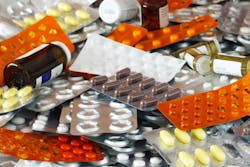It’s been said that "you are what you eat and drink," but in the case of pharmaceuticals and personal care products (PPCPs) in our drinking water, is that okay?
For several years, researchers have known that PPCPs can be found in the drinking water of most industrialized nations at very low concentrations. The term "pharmaceuticals" in drinking water refers to prescription, over-the-counter and therapeutic human and veterinary drugs. These can consist of all types of pharmaceuticals, including antibiotics, antidepressants and sex hormones. "Personal care products" refers to products used for personal and cosmetic reasons — such as soaps, shampoos, fragrances and cosmetics.
Residue of other personal care products that may be found in potable water can include diagnostic agents (such as injectable dyes used for medical imaging), sun screen products and neutraceuticals (such as vitamins and vitamin-infused foods and beverages). According to an investigative story, drinking water provided to at least 41 million people living in 24 major U.S. metropolitan areas had tested positive for trace amounts of pharmaceuticals.*
When PPCPs are excreted, discarded within the potable water supply (such as flushed down a toilet), or leach into freshwater supplies from livestock manure runoff, they do not simply disappear or completely dissolve away. Instead, the active ingredients and chemicals in such products can live on in the water supply, albeit at tremendously low levels of concentration (generally parts per trillion).
Effects of PPCP exposure
Some evidence exists of aquatic wildlife that has been affected by prolonged exposure to PPCP-tainted water, including feminization of male fish and masculinization of female fish, delayed sexual development in fish, delayed metamorphosis in frogs and embryo mortality.*
However, little is known about prolonged exposure to PPCPs among humans. According to a report on water sanitation health from the World Health Organization (WHO), "There are currently few systematic monitoring programmes or comprehensive studies available on human exposure to pharmaceuticals from drinking water."
Organizations such as WHO and the U.S. Environmental Protection Agency (EPA) are currently studying the pervasiveness of PPCP prevalence and its effect on humans. For instance, the EPA is examining the potential sources and occurrences of pharmaceuticals in wastewater effluent, biosolids and fish tissue.
That said, according to the WHO, "Current observations suggest that it is very unlikely that exposure to very low levels of pharmaceuticals in drinking water would result in appreciable adverse risks to human health, as concentrations of pharmaceuticals detected in drinking water [typically in the nanogram per liter range] are several orders of magnitude [usually more, and often much more, than 1,000-fold) lower than minimum therapeutic doses."*
Precautionary steps
Until researchers provide more definitive information on the impact of PPCPs on human life, individuals can protect themselves from prolonged PPCP exposure by consuming water that has been filtered by a reverse osmosis (RO) and/or ultrafiltration (UF) system —either municipally or using a home-based filtration system. Studies have found RO and UF methods capable of removing many of the most common pharmaceuticals found in drinking water.*
Consumers can also help relieve the issue of PPCP exposure by properly disposing of their unused or outdated PPCPs. Proper disposal means not discarding PPCPs in the sink, garbage disposal or toilet where it will continue to exist in the water supply, but instead disposing of such products in the garbage. EPA offers a guide on proper disposal.
Download the "Alternative Strategies for Managing Pharmaceutical and Personal Care Products in Water Resources" published in May 2011 by Texas Tech University School of Law here.
References:
- http://hosted.ap.org/specials/interactives/pharmawater_site/day1_01.html
- http://www.epa.gov/ppcp/faq.html
- http://www.who.int/water_sanitation_health/emerging/info_sheet_pharmaceuticals/en/index.html
- http://www.who.int/water_sanitation_health/emerging/info_sheet_pharmaceuticals/en/index.html
- http://www.who.int/water_sanitation_health/publications/2011/pharmaceuticals_20110601.pdf
Steven Coker has been with Dow Chemical for more than 35 years and has worked in various research and development and technical service functions. He is currently responsible for the design, commissioning and technical support of reverse osmosis membrane plants in North America. Steven has authored several technical papers on the application of ion exchange and membrane technology for water treatment and is a member of multiple water treatment associations, including AMTA, AWWA, CaribDA and IDA.


